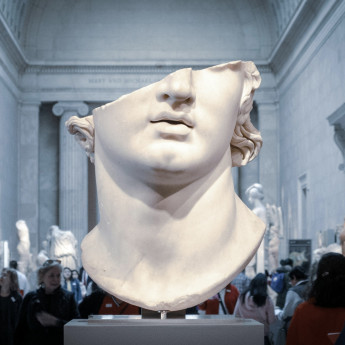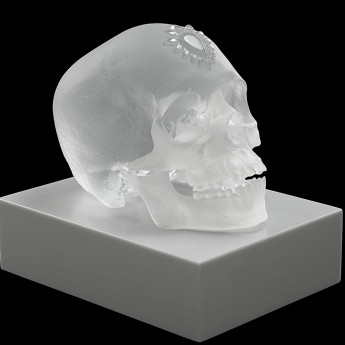


Details
Artist
Styles
Embossed prints, on Eskulan paper, with accompanying text sheet. Signed, dated, and numbered. Co-published by Dorothea van der Koelen, Mainz and Edouard Weiss, Paris. Literature: Van der Koelen, Dorothea and Martin (eds.): Günther Uecker - Opus Liber, Directory of Bibliophile Books and Works, Mainz 2007, Cat. No. L 0203, ill. pp. 507-511. Graphein VIII, Christen Ägypten (2002) by Günther Uecker is a refined embossed print from his Graphein series, a body of work that explores the act of writing and marking as both a physical and spiritual gesture. Created on handmade Eskulan paper, the work features an array of raised dots arranged in a subtle, radiating pattern, evoking both braille and celestial constellations. The tactile surface, devoid of color or pigment, emphasizes form and light—hallmarks of Uecker’s approach to sensory and meditative expression. The title refers to Christian communities in Egypt, possibly invoking themes of endurance, silent testimony, and cultural memory. This minimalist yet deeply symbolic piece invites the viewer to read through touch, reflection, and light, rather than language. Published in an edition of 120, with additional artist’s copies, it was co-produced by Dorothea van der Koelen in Mainz and Edouard Weiss in Paris, further affirming its place in Uecker’s philosophical and materially resonant oeuvre.
Graphein VIII, Christen Ägypten, 2002
form
Medium
Size
70 x 50 cm
- Inches
- Centimeters
Edition
Price
- USD
- EUR
- GBP
Details
Artist
Styles
Embossed prints, on Eskulan paper, with accompanying text sheet. Signed, dated, and numbered. Co-published by Dorothea van der Koelen, Mainz and Edouard Weiss, Paris. Literature: Van der Koelen, Dorothea and Martin (eds.): Günther Uecker - Opus Liber, Directory of Bibliophile Books and Works, Mainz 2007, Cat. No. L 0203, ill. pp. 507-511. Graphein VIII, Christen Ägypten (2002) by Günther Uecker is a refined embossed print from his Graphein series, a body of work that explores the act of writing and marking as both a physical and spiritual gesture. Created on handmade Eskulan paper, the work features an array of raised dots arranged in a subtle, radiating pattern, evoking both braille and celestial constellations. The tactile surface, devoid of color or pigment, emphasizes form and light—hallmarks of Uecker’s approach to sensory and meditative expression. The title refers to Christian communities in Egypt, possibly invoking themes of endurance, silent testimony, and cultural memory. This minimalist yet deeply symbolic piece invites the viewer to read through touch, reflection, and light, rather than language. Published in an edition of 120, with additional artist’s copies, it was co-produced by Dorothea van der Koelen in Mainz and Edouard Weiss in Paris, further affirming its place in Uecker’s philosophical and materially resonant oeuvre.
- Recently Added
- Price (low-high )
- Price (high-low )
- Year (low-high )
- Year (high-low )
What is activist art?
Activist Art is a form of art created to address social and political issues. It often involves public engagement and works closely with communities to raise awareness or inspire change. While it can include elements of performance art, it is not limited to this form. Examples include creating and distributing social protest posters or organizing community-based art projects that highlight specific causes.







































